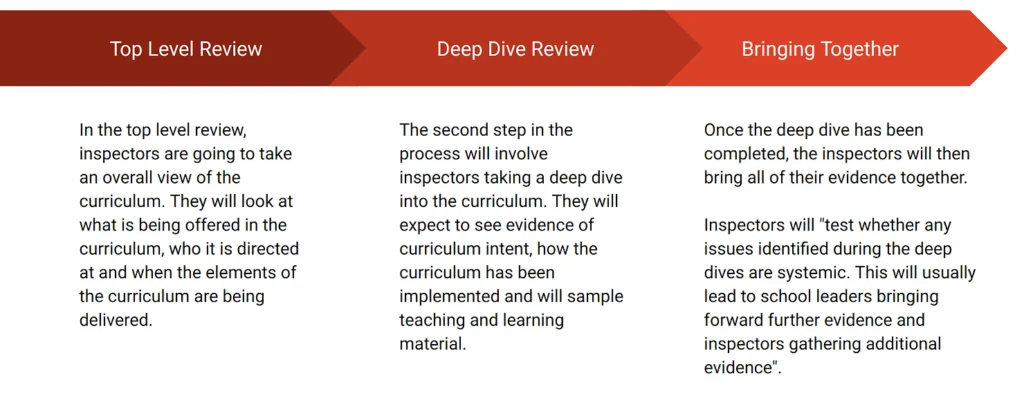Overview of the New Education Inspection Framework (EIF)
As of September 2019, OfSTED has implemented its new Education Inspection Framework (EIF), which will be used to inspect apprenticeship training, schools, and colleges. Given the significant changes it introduces, providers should urgently familiarise themselves with this framework. A notable inclusion is the Quality of Education judgement. While OfSTED has indicated a grace period for inspections from September 2019, allowing time for curriculum plans to be established, they expect to see active curriculum planning for all programmes.
Quality of Education Judgement
The Quality of Education judgement focuses on the quality of teaching, training, and curriculum planning for each apprenticeship standard. It demands detailed planning and clear evidence that delivery staff have thoughtfully considered the curriculum. OfSTED will evaluate the curriculum through a three-stage process:

OfSTED’s working definition of a curriculum is:
The curriculum is a framework for setting out the aims of a programme of education, including the knowledge and skills to be gained at each stage (intent); for translating that framework over time into a structure and narrative, within an institutional context (implementation) and for evaluating what knowledge and skills learners have gained against expectations (impact/achievement)
The three critical aspects here are:
- Curriculum Intent
- Curriculum Implementation
- Curriculum Impact
Apprenticeship Curriculum Intent
Providers must first consider the curriculum intent before addressing implementation and impact. This involves setting out the aims of the apprenticeship programme, including the knowledge and skills to be gained. These are outlined in the Apprenticeship Standards’ Knowledge, Skills, and Behaviours (KSBs). If providers have not transitioned from frameworks to standards, now is an opportune moment.
Next, providers need to translate the apprenticeship standard into a structured delivery plan with a coherent narrative – this is the implementation phase.
Finally, the impact of the delivery must be measured. Inspectors cannot rely solely on achievement data.
Apprenticeship Curriculum Intent Checklist
To assist apprenticeship training providers, the following checklist identifies key areas for curriculum planning:
Curriculum Intent:
- Define the knowledge apprentices should possess by the end of the programme.
- Identify the key topics apprentices must cover.
- Consider other delivery elements such as Prevent Guidance, Safeguarding, and extended Maths & English.
- Determine what knowledge will be gained in the workplace versus delivered in training.
- Assess the ambition level of apprentices: Are they adequately challenged, or is the content too basic or already covered in their workplace?
- Specify the delivery required for learners to achieve skills and behaviour standards.
- Ensure training staff are fully engaged with the curriculum and can affirm their involvement in its development.
- Make apprentices aware of the curriculum and the knowledge they will gain, including when and how.
- Support development for further learning, e.g., additional content for Level 3 programmes to prepare learners for higher-level courses.
- Define success benchmarks to demonstrate the necessary knowledge acquisition.
Curriculum Implementation:
- List curriculum activities such as workshops, topics, and block courses.
- Develop lesson plans and supporting teaching materials.
- Distinguish between theory, practical, and online learning needs.
- Address varying lengths of knowledge requirements.
- Include practice elements before confirming knowledge and conducting assessments.
- Handle learner differentiation effectively.
- Identify cross-curriculum links, such as connections to Maths & English, Prevent, or Safeguarding.
- Incorporate career guidance, stretching, challenging tasks, and additional learning into the curriculum.
- Ensure activities contribute to Off the Job Learning.
- Sequence activities logically to support learner progression.
- Verify learners have sufficient prior knowledge for subsequent activities.
- Align activities with workplace developments rather than just following the order listed in the apprenticeship standard.
- Conduct curriculum mapping to ensure activities cover all standards.
Curriculum Impact:
- Measure learner achievement of curriculum intent.
- Ensure learner assessments meet minimum benchmarks.
- Record areas for improvement and address these.
- Provide adequate assessments for learner feedback and development.
- Balance the volume of assessments to avoid overwhelming staff.
- Confirm learners have gained workplace-relevant knowledge.
- Verify employer satisfaction with apprentices’ knowledge and capabilities.
- Track End Point Assessment success rates, noting whether learners merely pass or excel.
Guidance for Implementing the EIF
To effectively implement the new Education Inspection Framework (EIF) and ensure a positive outcome during inspections, apprenticeship training providers should adhere to the following guidance:
Curriculum Intent
- Define Clear Objectives: Establish what knowledge, skills, and behaviours (KSBs) apprentices need to acquire by the end of the programme. These objectives should align with the Apprenticeship Standards.
- Engage Stakeholders: Involve training staff in curriculum development to ensure a thorough understanding and commitment. Their input is key to creating a relevant and robust curriculum.
- Communicate with Apprentices: Ensure apprentices know the curriculum content, structure, and expected learning outcomes. Clear communication helps apprentices understand their learning and objectives.
- Incorporate Comprehensive Elements: To provide a holistic educational experience, go beyond the core KSBs and include safeguarding, Prevent guidance, and additional support for Maths and English.
- Challenge and Ambition: Design a curriculum that challenges apprentices and goes beyond elementary knowledge, especially when upskilling existing staff. Aim to introduce new concepts and advanced knowledge.
Curriculum Implementation
- Structured Planning: Develop detailed lesson plans and teaching materials covering all curriculum aspects. Use various teaching methods, including theoretical, practical, and online learning.
- Sequence Logically: Organise learning activities logically that build on previous knowledge and support progressive learning. Ensure activities are timely and relevant to workplace developments.
- Address Differentiation: Provide differentiated instruction and additional support where necessary to cater to apprentices’ diverse learning needs.
- Integrate Cross-Curricular Links: Link the curriculum with broader educational goals, such as developing Math and English skills and addressing safeguarding concerns.
- Assessment and Feedback: Implement regular assessments to gauge learning progress and provide feedback. Balance the assessment load to prevent overwhelming staff and ensure meaningful feedback for apprentices.
Curriculum Impact
- Evaluate Outcomes: Use various metrics to evaluate whether apprentices have achieved the intended knowledge and skills. This includes regular assessments, feedback from employers, and the success rates of End Point Assessments (EPAs).
- Continuous Improvement: Record areas where learners need improvement and develop strategies to address these. Continuous monitoring and adaptation of the curriculum ensure it remains effective and relevant.
- Employer Feedback: Collect and analyse employer feedback to confirm that apprentices possess the necessary skills and knowledge for their roles. Employer satisfaction is a critical measure of the curriculum’s impact.
- Achievement and Excellence: Track the pass rates and the excellence in EPAs. Aim to support apprentices in excelling, not just meeting the minimum requirements.
Conclusion
Introducing OfSTED’s new Education Inspection Framework (EIF) presents challenges and opportunities for apprenticeship training providers. By focusing on the three pillars of the EIF—Curriculum Intent, Implementation, and Impact—providers can ensure they deliver high-quality education that meets the standards of OfSTED.
Providers should urgently familiarise themselves with the EIF and undertake detailed curriculum planning. Engage with all stakeholders to develop a robust curriculum, including training staff and apprentices. Implement structured and logically sequenced learning activities that cater to diverse learner needs and integrate cross-curricular links. Finally, continuously evaluate the impact of the curriculum through regular assessments and employer feedback to ensure apprentices are gaining the necessary skills and knowledge for their professional development.
By following this guidance, providers can meet OfSTED’s requirements and significantly enhance the quality of apprenticeship training, thereby supporting apprentices in achieving their full potential.


